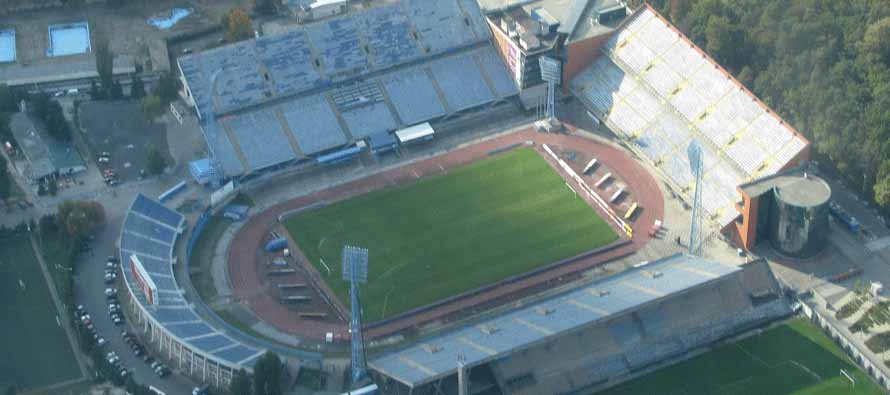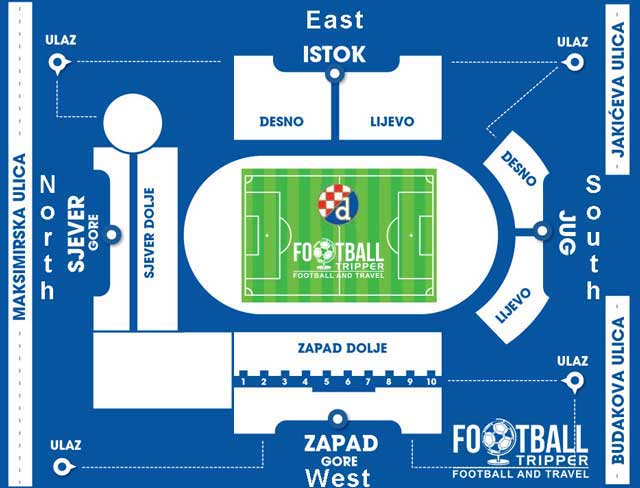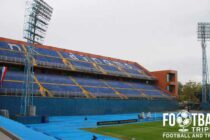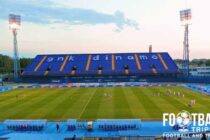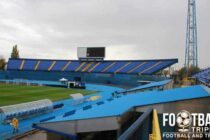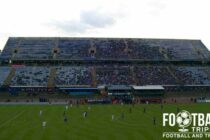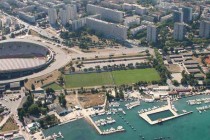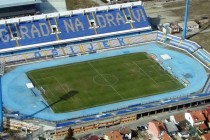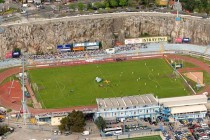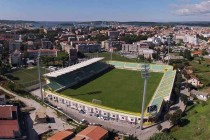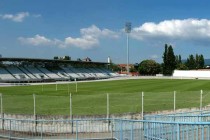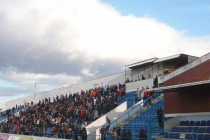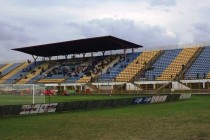Stadion Maksimir located in the capital city of Zagreb is the largest stadium in Croatia, with a capacity of 37,168 and besides being home of the famous GNK Dinamo Zagreb, it is also home of the National Football team. The stadium has underwent numerous renovations since opening in 1912, with the 1997 expansion arguably being the most significant.
Dinamo Zagreb Stadium Guide
Stadium Facts
| Overview | |
|---|---|
| Team: | Dinamo Zagreb |
| Opened: | 1912 |
| Capacity: | 38,079 |
| Address: | Maksimirska cesta 128, Zagreb, 10000 |
| Pitch Size: | 105 m x 68 m |
| Record Attendance: | 64,138 NK Zagreb vs Osijek (19th July 1973) |
| Stadium Owner: | City of Zagreb |
| Operator: | Dinamo Zagreb |
| Wikipedia: | https://en.wikipedia.org/wiki/Stadion_Maksimir |
| Stadium Names | |
| Names: | Maksimir Stadium (English) |
| Construction Details | |
| Broke Ground: | 1912 |
| Built: | 1912 |
| Architect: | Vladimir Turina, Branko Kincl |
| Renovated: | 1948, 1998, 2011 |
Stadion Maksimir History
Maksimir Stadium first opened on the 5th May 1912, and is a football ground which has undergone numerous renovations over the years, with the most famous perhaps coming after an arson attack in June 1941.
A few months prior, the fascist government had addressed young students from Zagreb encouraging anti-Semitism , and ordering them to segregate from their Jewish friends. The children disobeyed and a few months later rebels torched the stadium down in a brave act of defiance.
Rebuilt and nominated as one of the venues for the Euro 1976 tournament which was hosted by SFR Yugoslavia, The Maksimir hosted a handful of matches including the semi-final match between Netherlands and Czechoslovakia and the third place play-off between Netherlands and Yugoslavia.
1990 proved to be a turning point for Stadion Maksimir with an infamous riot taking place between supporters of Dinamo Zagren and Red Star Belgrade underlining the struggles for independence against Yugoslavia.
With Yugoslavia hosting their last national match at the Maksimir in June, 17th October saw Croatia play the United States in what turned out to be the country’s first international match of the modern era.
With Croatia firmly established as an independent nation, Stadion Maksimir was renovated in 1998 when the northern stand was rebuilt, increasing the ground’s capacity to 38,079.
The national team established a famous 16 year lossless record at Dinamo Zagreb’s stadium until England defeated the 4-1 in 2008 ending Croatia’s 30 game undefeated streak.
The stadium underwent a facelift in the Summer of 2011 with the city and football club jointly exploring the option of a brand new 55,000 capacity stadium in the Kajzerica neighbourhood dubbed “The Blue Volcano”.
Sadly, the project was abandoned in October 2012 after failing to get off the ground as a public referendum was never held.
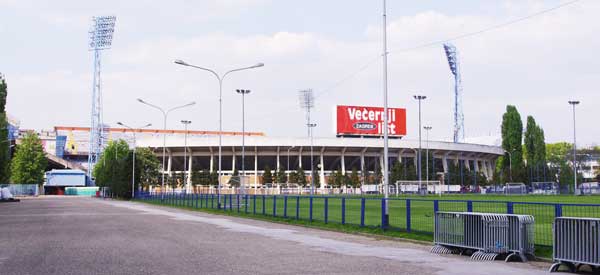
View of Stadion Maksimir
Future Developments
There are plans to replace the current stadium with a design known as “The Blue Volcanco” however so far it has been nothing but a pipe dream.
Dinamo Zagreb Info
| Full Name: | Građanski nogometni klub Dinamo Zagreb (Dinamo Zagreb Citizens' Football Club) |
|---|---|
| Rivals: | Hajduk Split (Eternal Derby), HNK Rijeka, Red Star Belgrade, Partizan |
| Founded: | 1911 |
| Team Colours: | Blue |
| Club Mascot: | Bull dog |
| Nicknames: | Modri (The Blues), Purgeri (The Citizens), Dinamo (DZG) |
| Former Stadiums: | Stadion Koturaška |
| Famous Players: | Eduardo da Silva, Mateo Kovačić, Mario Mandžukić, Mark Viduka, Davor Šuker |
| Famous Managers: | Krunoslav Jurčić, Velimir Zajec, Ante Čačić, Miroslav Blažević |
| Team Owner: | Mirko Barišić |
| Team Goalscorer: | Igor Cvitanović (304) |
| Most Appearances: | Dražen Ladić (802) |
| Official Website: | https://www.gnkdinamo.hr/ |
| Team Wikipedia: | https://en.wikipedia.org/wiki/GNK_Dinamo_Zagreb |
Croatian National Team Info
| Full Name: | Croatia National Football Team |
|---|---|
| Rivals: | Italy (Derby Adriatico), Serbia |
| Founded: | 1994 |
| Team Colours: | Red and White |
| Nicknames: | Vatreni (The Blazers), Kockasti (The Checkered Ones) |
| Famous Players: | Darijo Srna, Stipe Pletikosa, Ivan Rakitić, Niko Kranjčar, Ivan Perišić |
| Famous Managers: | Miroslav Blažević, Slaven Bilić, Zlatko Dalić, Zlatko Kranjčar, Ante Čačić |
| Team Owner: | Croatian Football Federation (HNS) |
| Team Goalscorer: | Davor Šuker (45) |
| Most Appearances: | Luka Modrić (142+) |
| Team Wikipedia: | https://en.wikipedia.org/wiki/Croatia_national_football_team |
Stadion Maksimir Seating Plan
Stand Photos
Matchday Experience
Stadion Maksimir Away Section
Away fans are usually housed within the south stand which is the curved one (see the pictures above).
There isn’t really a set allocation of away tickets for domestic matches as games rarely sell out, however for European games you’re looking at a minimum of 1,900 based on UEFA’s 5% policy.
The south stand is often split into two sides, with the away fans usually occupying the “desno” section which means the one on the right.
Best Pubs near ground
Zagreb is a lively city with numerous bars and pubs located within the area surrounding the main square. Most football fans choose to drink centrally before hopping on the tram in time for kick-off.
Dinamo Zagreb Club Shop
If you’re attending a match then you will encounter various kiosks and stalls selling a mixture of official and unofficial GNK Dinamo merchandise.
As there isn’t a permanent shop any more which means you should visit the GNK DZ web shop if you wish to purchase mementos and souvenirs.
Can you take a stadium Tour?
It doesn’t appear as if the ground’s owners, the City of Zagreb, currently offer tours of Stadion Maksimir. If this ever changes we’ll be sure to update this section.
How to buy Dinamo Zagreb Tickets
Tickets to see Dinamo Zagreb at home can either be purchased in the days leading up to the match from the stadium’s ticket office or online from the official website. The box office is usually open Monday to Friday 9.00 am – 5.00 pm and for a few hours before kick-off as games rarely sell out.
Ticket Prices
- Tribuna Sjever (North): 10.00 kn
- Tribuna Istok (East): 20.00 kn
- Tribuna Zapad (West): 30.00 kn
Please note that ticket’s to see your country take on Croatia should be purchased in advance from your national football association/federation.
How to get to Stadion Maksimir
Where is Stadion Maksimir?
Dinamo Zagreb’s home ground is located at the foot of Maksimir Park approximately 3.5 km east of the city centre along Maksimirska cesta.
Driving
The stadium’s address for satnav is as follows:
- Maksimirski perivoj, 10000, Zagreb, Croatia
Car Parks
The small car park to the west of the stadium is reserved on matchdays to guests of the club which means driving isn’t really encouraged when there’s a match on.
Train - Public Transport
The main railway station – “Zagreb Glavni kolodvor” sits 1 km south of the historic square in the city centre. As the main hub of Croatian Railways and the largest station in Croatia it is well connected to both the rest of the country and Europe.
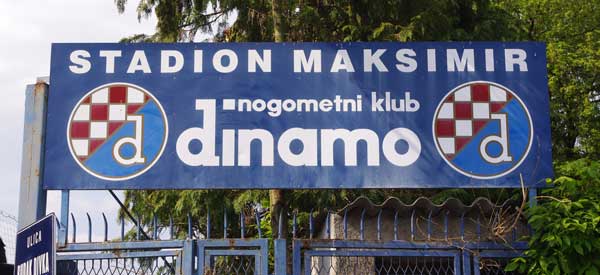
Public Transport of Stadion Maksimir
Airports and Flying
Zagreb International Airport is approximately 16 km south-east of Zagreb city centre. Known as Pleso Airport after the suburb it sits within, it is the largest airport in Croatia which all but guarantees numerous flights around Europe and the World.
Upon landing you can catch a bus service into the city in around 25 minutes at a cost of 30 kuna for a single ticket.
Hotels Near Stadion Maksimir
There are numerous affordable accommodation options within a 10 minute walk of the main railway station. You will encounter recognisable names such as DoubleTree by Hilton, to smaller independents such as Hotel Dubrovnik and Hotel Westin.
Frequently Asked Questions
Who plays at Stadion Maksimir?
Croatian side Dinamo Zagreb play their home matches at Stadion Maksimir.
What is the capacity of Stadion Maksimir?
As of 2025 Stadion Maksimir has an official seating capacity of 38,079 for Football matches.
When was Stadion Maksimir opened?
Stadion Maksimir officially opened in 1912 and is home to Dinamo Zagreb
What is the postcode for Stadion Maksimir?
The postcode for Stadion Maksimir is 10000.
Are there any Covid restrictions at the stadium?
Covid Restrictions may be in place when you visit Stadion Maksimir in 2025. Please visit the official website of Dinamo Zagreb for full information on changes due to the Coronavirus.

